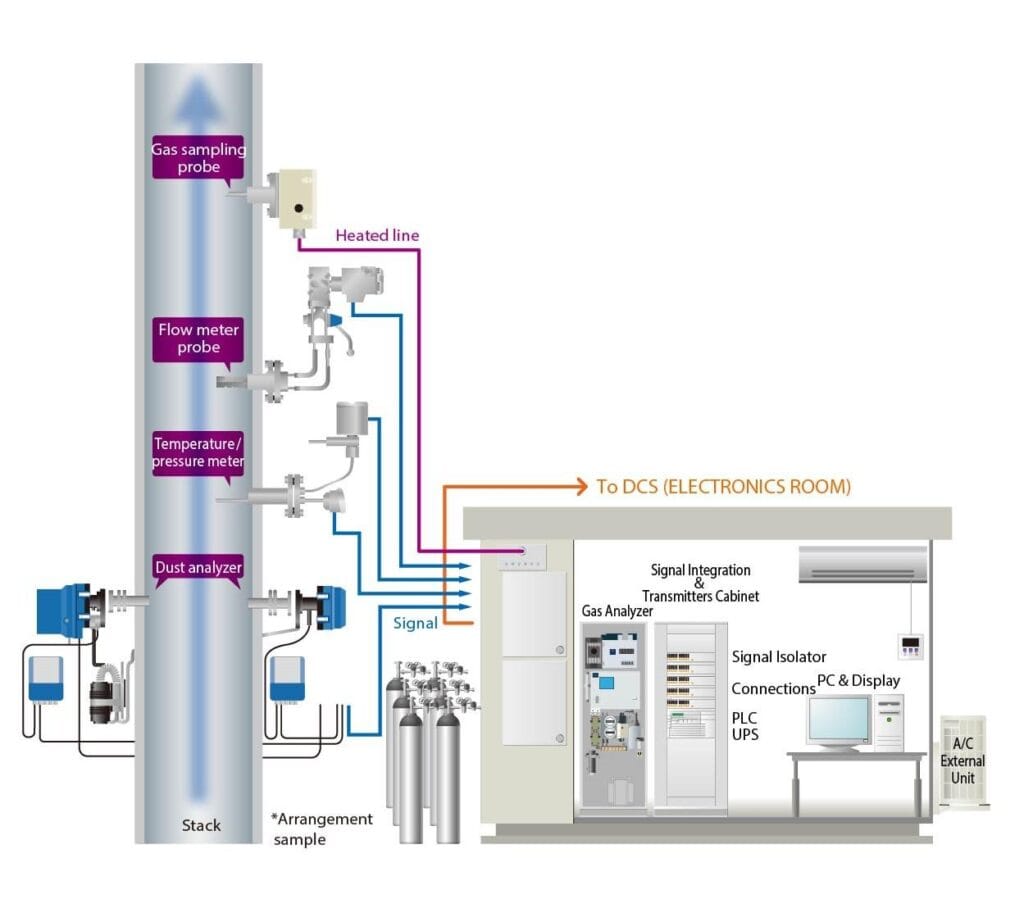In This Article
What is industrial emissions and smog?
Industrial emissions are the release of pollutants into the atmosphere from industrial processes. It is a major contributor to the air quality issues. Industrial emissions are harmful substances released into the atmosphere from activities in factories, mines, mills, and refineries. These pollutants include:
Airborne Pollutants: Including nitrogen oxides (NOₓ), sulfur dioxide (SO₂), particulate matter (PM), and volatile organic compounds (VOCs).
Greenhouse Gases (GHGs): Such as carbon dioxide (CO₂) and methane (CH₄), exacerbate climate change by trapping heat in the atmosphere.
Smog is a mixture of pollutants, ground-level ozone and particulate matter. Smog is commonly a mix of smoke and fog. The importance of this topic is to evaluate the contribution of industrial emissions to smog.
Types of Industrial Emissions & Smog
There are two types of pollutants based on their intensity.
1. Primary Pollutants:
The primary pollutants are Particulate Matter (PM), Sulfur Dioxide (SO₂), Nitrogen Oxides (NOₓ), Volatile Organic Compounds (VOCs) and Carbon Monoxide (CO)
2. Secondary Pollutants:
The secondary pollutants are ground-level ozone (O₃) and Secondary particulate matter is formed through chemical reactions.
Formation of Smog
There are two types of smog and are formed differently.
1. Photochemical Smog:
Photochemical smog is formed when sunlight reacts with Nitrogen oxide NOₓ and volatile organic compounds (VOCs) to produce ground-level ozone. It is a brownish-grey haze that contains air pollutants generated from human activities, mainly ozone, nitric acid, and organic compounds that are trapped near the ground by temperature inversion.

2. Industrial Smog:
Industrial smog is formed when fossil fuels are burned. Sulfurous smog is the other name for industrial smog that forms in cold and humid conditions. Sulfurous smog or London smog results from a high concentration of sulfur oxides in the air and is caused by sulfur-bearing fossil fuels, particularly coal in industries. The type of smog is aggravated by dampness and a high concentration of suspended particulate matter in the air.

Sources of Industrial Emissions
- Combustion of Fossil Fuels: In industrial operations to produce energy fossil fuels like coal, oil, natural gas and petroleum are burned. Industrial emissions and smog formation due to release significant amounts of CO₂, methane, NOₓ, and SO₂, contributing to smog, acid rain, and global warming.
- Use of Chemical Solvents: In industries chemical solvents are extensively used in industries such as tanning, dyeing, and pharmaceuticals. As a result, these solvents can evaporate into the atmosphere, leading to air quality degradation and the formation of ground-level ozone.
- Disposal of Untreated Gas and Liquid Waste: In many industries, industrial discharge is the untreated gaseous emissions (e.g., ammonia, VOCs) and liquid waste (e.g., heavy metals, toxic chemicals) into the environment leading to smog. These practices contaminate air, water, and soil, posing risks to human health, ecosystems, and biodiversity reducing industrial emissions minimizes environmental harm and protects public health.
- Improper Disposal of Radioactive Materials: The improper handling and disposal of industrial emissions like radioactive substances from industrial emissions and smog contribute to environmental formation and pose significant health risks.
- Agricultural Activities: The use of pesticides and fertilizers, along with practices such as flooding rice fields, releases harmful chemicals and methane into the atmosphere, impacting air and water quality.
- Power Plants: Burning fossil fuels to produce electricity and heat generates significant emissions, including carbon dioxide (CO₂), sulfur dioxide (SO₂), and nitrogen oxides (NOₓ).
- Oil Refining: The process of refining crude oil releases pollutants such as CO₂, NOₓ, and hydrogen sulfide (H₂S), contributing to air pollution and climate change.
- Coal Mining: Extracting and processing coal emits greenhouse gases, particulate matter, and other pollutants, impacting air quality and accelerating environmental degradation.
Impact of Industrial Emissions and Smog
Health Impacts:
There are several impacts of industrial emissions and smog as it is a key factor in the loss of agricultural productivity. The health impacts of industrial emissions and smog are respiratory and cardiovascular diseases. The premature deaths are due to air pollution.
Environmental Impacts:
The environmental impact of industrial emissions and smog is acid rain formation. It damages the ecosystem and the biodiversity as well.
Economic Costs:
The financial loss the industrial emissions and smog is the healthcare expense when one is through disease.
Monitoring And Regulations of Industrial Emissions & Smog
Governmental agencies such as regulatory bodies in the European Union and the Environmental Protection Agency(EPA) in the United States play a major role in enforcing and establishing industrial emission standards. These standards are developed to limit the release of pollutants and gaseous discharge from the industries to adopt cleaner sustainable practices.
Technologies for Monitoring
Industrial emissions to show compliance with regulations through modern technologies to accurately monitor them are essential.
- Continuous Emission Monitoring Systems (CEMS): It is a system of instruments that continuously measures pollutants from industrial emissions into the atmosphere. This system is used to measure pollutants emitted in permissible amounts in the atmosphere.

- Remote Sensing Technologies: The measurement of emissions over large areas, offering a non-invasive method to monitor industrial activities and their environmental impact through Advanced Remote Sensing tools for detection.
International Treaties
The widespread impact of industrial emissions on climate change and air quality through Global Agreements is established.
- Kyoto Protocol: A set of binding targets for the reduction of greenhouse gas emissions, particularly for developed nations was the First International Treaty.
- Paris Agreement: The Paris Agreement aims to limit global warming by encouraging countries to commit to ambitious emission reduction targets and transition to low-carbon economies. This was built under Kyoto Protocol aims. The collective measures to regulate industrial emissions and smog create a balance between economic growth and environmental sustainability.
Mitigation Strategies
Adoption of Cleaner Technologies
One of the most effective ways to reduce industrial emissions is by adopting cleaner and more sustainable technologies.
- Transition to Renewable Energy Sources: Shifting from fossil fuels to renewable energy options, such as solar, wind, and hydroelectric power, can significantly lower greenhouse gas emissions while ensuring energy reliability.
- Carbon Capture and Storage (CCS): This Carbon capture and storage (CSS) technology involves capturing carbon dioxide emissions from industrial processes and storing them underground or using them in other applications, thereby preventing their release into the atmosphere.
Process Optimization in Industries
Industries can mitigate emissions by improving operational efficiency and adopting advanced techniques:
- Improved Efficiency in Production Methods: In manufacturing processes and minimizing waste generation can reduce the environmental footprint of industrial activities by enhancing energy efficiency. By streamlining workflows and upgrading equipment are critical steps in achieving this.
Legislation and Policies
Governmental regulations and policies play a vital role in curbing industrial pollution.
Stricter Enforcement of Emission Norms: Imposing stringent emission limits and ensuring compliance through regular inspections and penalties can compel industries to adopt environmentally friendly practices. Incentives for industries meeting or exceeding these norms can further drive progress.
Public Awareness and Collaboration
Collaborative efforts and increased public consciousness are essential for long-term success in mitigating industrial emissions:
Corporate Social Responsibility (CSR): Industries can take proactive measures by integrating sustainability into their business models, investing in green technologies, and supporting environmental conservation projects.
Community Initiatives: Engaging communities in emission reduction efforts, such as local clean-up campaigns, afforestation programs, and public education on air quality, fosters collective responsibility and action.
These strategies collectively aim to reduce industrial emissions, promote sustainable development, and protect the environment for future generations.
Challenges in Addressing Industrial Emissions
Technological and Financial Barriers
The implementation of cleaner and more sustainable technologies often involves significant upfront costs, which can deter industries from adopting them. A shortage of technical expertise and knowledge further complicates the deployment and maintenance of advanced emission-reduction technologies.
Policy and Enforcement Issues
In many developing countries, regulations governing industrial emissions are either insufficient or poorly enforced, allowing industries to operate without strict environmental oversight. Resistance from industrial sectors, driven by concerns over increased operational costs and potential impacts on profitability, poses a significant hurdle to implementing stricter emission controls.
Global Disparities
There are vast differences in the levels of industrialization and availability of resources among countries. Developing nations may lack the financial and technical capabilities to invest in advanced emission-control measures, further widening the gap in global emission reduction.
Conclusion
Reflecting on the Key Points
Addressing industrial emissions and smog is not just an environmental challenge—it’s a pressing global responsibility. From the harmful pollutants released into our air to the health and climate impacts they cause, it’s clear that reducing industrial emissions is essential for a healthier, more sustainable future.
A Call to Action
Governments must enforce stricter regulations, industries need to adopt cleaner technologies, and individuals can support sustainable practices and demand change. We all have a role to play in tackling this issue. Together, our collective efforts can make a real difference in improving air quality i.e.; industrial emissions and smog and safeguarding our planet.
Looking Ahead
As innovations in technology and international collaboration pave the way for the future to hold hope of greener industrial practices. By working hand in hand, we can create a world where progress doesn’t come at the expense of our environment, ensuring a better legacy for generations to come.
Frequently Asked Questions:
1. What are industrial emissions?
Industrial emissions refer to pollutants released into the environment from industrial activities such as manufacturing, mining, refining, and power generation. These pollutants include greenhouse gases, particulate matter, sulfur dioxide, nitrogen oxides, and volatile organic compounds.
2. How do industrial emissions contribute to smog?
Industrial emissions release nitrogen oxides (NOₓ) and volatile organic compounds (VOCs) into the atmosphere. These chemicals react with sunlight to form ground-level ozone, a key component of photochemical smog. Particulate matter from industries also contributes to haze and smog formation.
3. What are the main sources of industrial emissions?
The key sources include:
Burning fossil fuels for energy.
Chemical processes in industries like tanning, dyeing, and pharmaceuticals.
Refining oil and processing coal.
Disposing of untreated gas and liquid waste.
Improper handling of radioactive materials
4. What is the difference between photochemical smog and industrial smog?
Photochemical Smog: It forms in sunny conditions when NOₓ and VOCs react with sunlight, producing ozone and other pollutants.
Industrial Smog: Results from burning fossil fuels like coal, particularly in cool and humid climates, and is dominated by sulfur dioxide and particulate matter.
5. What are the health impacts of smog?
Smog can cause:
Respiratory issues like asthma, bronchitis, and reduced lung function.
Cardiovascular problems.
Premature deaths due to prolonged exposure.
Irritation of the eyes, nose, and throat.








